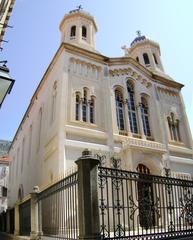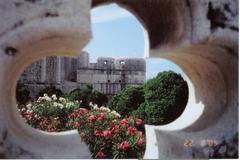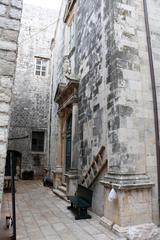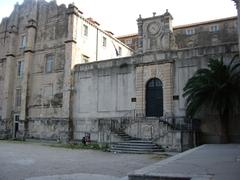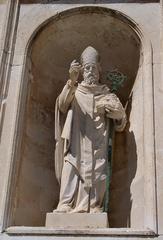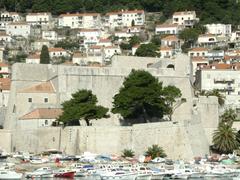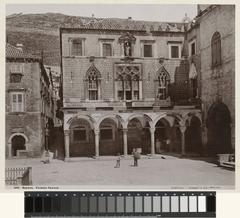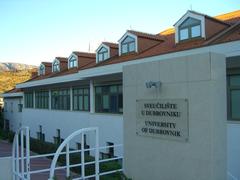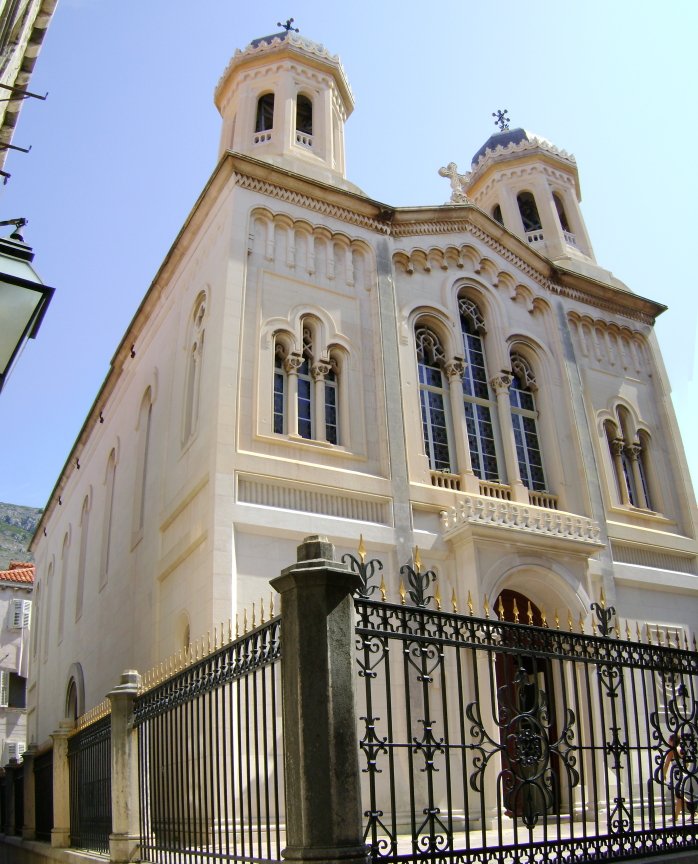
Holy Annunciation Orthodox Church Dubrovnik: Visiting Hours, Tickets, and Historical Significance
Date: 15/06/2025
Introduction
Nestled within Dubrovnik’s UNESCO-listed Old City, the Holy Annunciation Orthodox Church stands as a powerful symbol of the city’s multicultural and religious heritage. As the only Serbian Orthodox church within the ancient city walls, this Neo-Byzantine landmark not only serves as a place of worship but also holds a rich collection of icons, manuscripts, and artifacts, making it a must-visit for history enthusiasts, art lovers, and cultural travelers alike. This comprehensive guide provides detailed information on the church’s history, architectural features, visiting hours, ticketing, accessibility, and nearby attractions, ensuring a meaningful and well-informed experience for every visitor (Total Croatia News; Go Dubrovnik Guide; Dubrovnik Tourist Board).
Table of Contents
- Historical Background
- Religious Life and Cultural Role
- Visiting Information
- Location, Getting There, and Travel Tips
- Nearby Attractions
- Visual Highlights and Media
- Frequently Asked Questions (FAQ)
- Summary and Final Tips
- References
Historical Background
Origins and Construction
The Holy Annunciation Orthodox Church was constructed in 1877, marking a pivotal moment for the Serbian Orthodox community in Dubrovnik. Built in the Neo-Byzantine style, the church stands at Ulica od Puča 8, symbolizing the integration and resilience of the Orthodox population in a city historically dominated by Catholicism. The church’s establishment was made possible through donations from Orthodox merchants and families, reflecting a spirit of pan-Orthodox solidarity during a time of significant cultural and political shifts in the Balkans (Go Dubrovnik Guide).
Architectural Features and Artistic Heritage
The church’s Neo-Byzantine exterior, featuring symmetrical stonework, arched windows, and a modest bell tower, sets it apart from Dubrovnik’s predominantly Baroque and Gothic Catholic churches (Dubrovnik Times; TripHobo). Its dignified façade leads into an ornate interior highlighted by a richly decorated iconostasis crafted in 1883 by Spyridon Speranza. The iconostasis, with its gilded woodwork and vibrant icons, is the visual and spiritual centerpiece of the church. The collection of icons, some dating as far back as the 15th century, showcases the evolution of Orthodox iconography and the community’s artistic legacy (Dubrovnik City Guide).
Wartime Damage and Restoration
During the Yugoslav Wars, particularly the Siege of Dubrovnik in the early 1990s, the church suffered significant damage. Despite these challenges, it remained a symbol of resilience for the local Orthodox community. Comprehensive restoration, completed in 2009 and funded by Croatian cultural institutions and private donors, ensured the preservation of the church’s structure and invaluable icon collection (Total Croatia News).
Museum and Library Collections
The church houses a notable museum and an extensive library. The museum displays religious artifacts such as a copy of the Miroslav Gospels (1897), a gospel printed in Moscow (1805), and a New Testament from Kiev (1703). It also features 18 portraits, including works by the renowned Croatian painter Vlaho Bukovac, and busts of prominent cultural figures. The library comprises over 12,000 volumes, primarily in Church Slavonic, but also in Italian, French, and Russian, making it a valuable resource for scholars and the Orthodox community alike (Go Dubrovnik Guide; Dubrovnik Times).
Religious Life and Cultural Role
The Holy Annunciation Orthodox Church continues to serve as an active place of worship, following the Julian calendar for feast days and major celebrations such as Easter and the Annunciation. Services are conducted primarily in Church Slavonic, with Serbian and occasionally Greek, reflecting the community’s diversity (Serbian Orthodox Church Calendar). The church also functions as a cultural hub, hosting exhibitions, lectures, and interfaith events in collaboration with organizations such as the Serbian Cultural Society “Prosvjeta” (Prosvjeta Dubrovnik). This ongoing engagement sustains the cultural identity of Dubrovnik’s Orthodox population and fosters interfaith understanding in the city (Jewish Community of Dubrovnik).
Visiting Information
Visiting Hours
- Standard Opening: Tuesday through Sunday, 9:00 AM to 5:00 PM.
- Closed: Mondays and major Orthodox/Catholic holidays.
- Note: Visiting hours may vary during religious services or special events. Always check locally for updates (Evendo).
Admission and Tickets
- Entry: Free for all visitors as of June 2025.
- Donations: Welcome to support church maintenance and charitable activities.
- Tickets: No reservation or advance ticketing required (Dubrovnik Times).
Accessibility
- The church is accessible via the flat, paved streets of the Old Town, though there is a small step at the entrance.
- Wheelchair ramps and staff assistance are available, but some uneven cobblestones in the Old Town may pose challenges.
- Contact the parish office in advance if special assistance is needed (Evendo).
Guided Tours and Events
- Guided Tours: Available on request through local tour operators or the Dubrovnik Tourist Board. These tours provide deeper insights into the church’s history, art, and religious significance.
- Special Events: The church occasionally hosts religious festivals and cultural events, especially during Orthodox feast days. Visitors are welcome to observe respectfully.
Location, Getting There, and Travel Tips
- Address: Ul. od Puča 8/11-9, Dubrovnik Old Town.
- On Foot: Easily accessible from the Stradun and nearby historic sites.
- By Car: Park outside the Old Town (e.g., at Pile Gate), as the Old Town is pedestrian-only.
- Public Transport: Dubrovnik’s main bus station is a 20-minute walk away; taxis and rideshares are also available (Evendo).
- Best Time to Visit: Early morning or late afternoon for a quieter experience and ideal lighting for photos.
- Dress Code: Modest attire required; shoulders and knees covered, hats removed inside.
- Photography: Permitted in the museum and exterior; always ask permission before photographing inside, especially during services.
Nearby Attractions
The church’s central location makes it an excellent addition to a walking tour of Dubrovnik’s Old Town. Notable nearby sites include:
- Dubrovnik Cathedral: The city’s primary Catholic church.
- Rector’s Palace: Museum of Dubrovnik’s political history.
- Sponza Palace: Renaissance palace housing city archives.
- Stradun: Main pedestrian street with shops and historic buildings.
- Franciscan Monastery: Renowned for its ancient pharmacy and cloister.
Visual Highlights and Media
For an enhanced experience, look for high-quality images and virtual tours of the Holy Annunciation Orthodox Church on official tourism websites and travel apps. Suggested alt tags for images:
- “Holy Annunciation Orthodox Church Dubrovnik façade”
- “Neo-Byzantine iconostasis inside Holy Annunciation Church”
- “Museum artifacts at Holy Annunciation Orthodox Church”
Interactive maps are also available to help visitors navigate the Old Town (Dubrovnik Tourist Board).
Frequently Asked Questions (FAQ)
Q: What are the opening hours?
A: Tuesday–Sunday, 9:00 AM to 5:00 PM; closed Mondays and major holidays.
Q: Is there an entry fee?
A: No, entry is free; donations are welcome.
Q: Are guided tours available?
A: Yes, by request through local tour operators or the Dubrovnik Tourist Board.
Q: Is the church wheelchair accessible?
A: Accessible via ramps, but some uneven terrain in the Old Town. Contact ahead for assistance.
Q: Can I take photographs inside?
A: Photography is allowed in the museum and exterior; always request permission before photographing inside.
Q: What is the best time to visit?
A: Early mornings or late afternoons to avoid crowds and enjoy optimal lighting.
Summary and Final Tips
The Holy Annunciation Orthodox Church is more than a historical monument—it is a living testament to Dubrovnik’s multicultural spirit. Its Neo-Byzantine architecture, remarkable icon collection, and serene ambiance make it an essential stop for anyone seeking to understand the city’s diverse heritage. Enjoy free entry, central location, and a tranquil atmosphere that invites both reflection and exploration. Pair your visit with nearby attractions for a comprehensive cultural experience. For additional guidance, download the Audiala app, and check local tourism resources for the latest updates.
References
- This is a sample text. (Total Croatia News)
- This is a sample text. (Go Dubrovnik Guide)
- This is a sample text. (Dubrovnik Tourist Board)
- This is a sample text. (Dubrovnik Times)
- This is a sample text. (Lonely Planet)
- This is a sample text. (Evendo)
- This is a sample text. (TripHobo)
- This is a sample text. (Dubrovnik City Guide)
- This is a sample text. (Serbian Orthodox Church Calendar)
- This is a sample text. (Prosvjeta Dubrovnik)
- This is a sample text. (Jewish Community of Dubrovnik)
